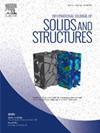Geometric symmetry and mechanical behavior of Topologically Interlocked Material systems from skewed building blocks
Abstract
Architectured materials are engineered materials with specific geometries and arrangements to exhibit desired mechanical properties. One class of architectured material is the Topologically interlocked material (TIM) system. In TIM systems, a plurality of convex particles is assembled under specific geometric constraints such that a load-carrying structure is obtained without the need for an adhesive bond between building blocks. Past investigations have considered TIM systems with building blocks and assemblies with a high degree of symmetry. Here the geometric constraints commonly imposed on the geometry of the system are relaxed. Two new types of skewed building blocks are introduced: one with only a rotational symmetry and no mirror symmetry, and one without rotational or mirror symmetry. These blocks are used to build even and odd-numbered assemblies and to create TIM systems with both mirror and rotational symmetry, rotational symmetry only, and no symmetry. A vector field representing the material architecture is introduced and demonstrated to connect architecture and mechanical behavior. It is demonstrated that load transfer patterns in the TIM system closely match the geometric symmetry. This allows for the demonstration of achiral and chiral mechanical behavior as represented by the presence of reaction moments for the centrally loaded square TIM assembly. The chirality of the building blocks manifests itself in the mechanical behavior of the TIM system only once the deflection of the system opens the contacts between building blocks such that building blocks accommodate deformation. Chiral building blocks diffuse the load from the central load path dominant in the TIM systems built from achiral blocks. This construction concept allows for simultaneous improvements in mechanical properties (strength and stiffness) solely from geometry.

 求助内容:
求助内容: 应助结果提醒方式:
应助结果提醒方式:


